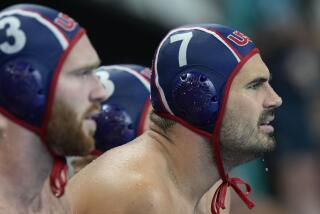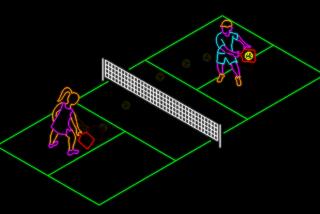Horse Play
- Share via
Polo has a deservedly upscale reputation, considering the cost and upkeep of the primary equipment: horses.
But you don’t have to own a horse to play polo. And though traditional polo on a grass field might be out of reach of those with modest incomes, arena polo is easier on the bank account.
“Arena polo is for regular people,” said Denny Geiler, president of Playa Grande Polo Club in Huntington Beach. “We’ve had truck drivers, secretaries, airline stewardesses, insurance salesmen--every walk of life--play this sport. The key factor is: They love horses.”
The club, on the grounds of the Huntington Central Park Equestrian Center, is the only location in the county the public can take polo lessons and play.
The perception in this country is that polo is a rich person’s sport. But club manager Louise Mayer, who teaches at the club, said “every sport runs into money, no matter how you look at it. In golf, you pay green fees, for equipment, clothing. The only difference is, you’re not feeding it everyday.”
Arena polo is played between two three-person teams on a 100-yard by 50-yard fenced-in dirt field. The teams play four chukkers [quarters], of about 7 to 7 1/2 minutes (some timekeepers can be liberal), with a break between each chukker to change horses. The object is to hit a ball about eight inches in diameter with a mallet into the opposing goal. Players ride one horse for the first and third chukker, and another for the second and fourth, because play is so exhausting for the animal.
Mayer, who gives lessons, said all that’s necessary to learn is a pair of Western-style boots with heels. The price of her lessons--about $50 per private session--includes use of a horse, mallet, riding crop and helmet. She estimates that a person, even someone who doesn’t know how to ride, could be competing within six to seven months if they take one or two lessons per week. There are also package deals: $200 buys five lessons.
*
Be warned: Players say the sport is addictive.
Take Dave Schuberth, a mortgage banker from Huntington Beach. About seven months ago, his daughter, who rides on the Cal Poly Pomona equestrian team, bought him a polo lesson with Mayer for his birthday.
Now, he owns a horse and plays three or four times a week.
“I had ridden very little before,” he said. “My daughter’s ridden four or five years, so I’ve been around horses, but just through her.”
Then he took a lesson. And another.
“This is a sport for competitive people who like exciting sports and who like horses,” he said. “And I like the people I’ve met through the club.”
The club, which is about 20 years old, has about 15 or 20 members who play regularly. Some, like Schuberth, are recent converts. Others, like Jesse Quirante, who was born and reared in the Philippines, have been playing since they were teenagers.
“My family was in the military,” said Quirante, a Gardena resident who runs a recycling business. “I started riding when I was very young. I eventually became a teacher.
“What I did was a little rodeo, a little roping, some jumping, some racing. You put them all together, and you find it in polo.”
People are attracted to the sport for a variety of reasons.
“What I like about it is the fact it is difficult,” said Long Beach advertising executive Scott Zimmer. “The great thing is, we’re able to come out here and play against really, really great players. . . . When you’re starting out, you start slowly. Now [at his level] it’s as fast and competitive as you want it to be. It depends on how competitive your spirit is.”
Meeting people who played piqued Zimmer’s curiosity about the sport.
“Over time, I ran into some people who had played the game,” said Zimmer, who has been playing for about 2 1/2 years. “And their passion for the game got me interested. I happened to move my business from Long Beach to Huntington Beach, and everyday as I was driving to work, I’d have to drive past this arena. So I just drove in one day and signed up. I’d never even ridden a horse before. Now I own two.”
*
Playa Grande players travel to clubs in San Diego, Los Angeles, Riverside and Santa Barbara counties for games and tournaments. In Indio, the competition is on the traditional grass field, which is 300 yards by 150 yards and played four-on-four.
Riders prefer mares to geldings. Most of the horses--or polo ponies, the preferred term--are thoroughbreds, because of the need for speed. But quarter horses, Arabians and appaloosas are also ridden.
“The horses play the game,” said Geiler, an Irvine lawyer who has been club president about five years. “I’ll get one of my horses, and riding up toward the arena, it’ll be like a trail ride. Kind of a slow, relaxed pace. As soon as they get on the field, you can feel their energy. They love to play the game.”
Playing is a good way to learn to ride. “People learn how to ride faster when they’re learning to play the game because you’re thinking about so many things when you’re playing, the riding comes naturally,” Geiler said.
And it can be a family sport, as in the case of Schuberth, where the sport was passed from daughter to father. Geiler said in the club, there are husbands and wives and a pair of brothers.
Horses cost as little as $1,500, but more expensive ones can cost more than $5,000. Boarding at the equestrian center is about $225 a month, which includes feed. Sawdust for stall floors is about $25 per month, and the horses have to be shod every six weeks or so, at a cost of about $75. With luck, vet bills are not prohibitive.
If a player doesn’t own a horse, he or she pays $30 per chukker to use one of club’s animals.


